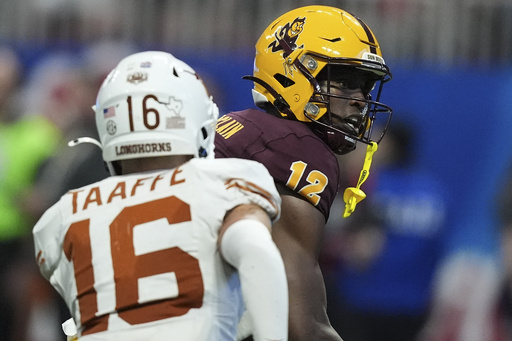ATLANTA — In a pivotal moment during the Peach Bowl, the officiating crew chose not to call a targeting penalty against Texas safety Michael Taaffe for a significant helmet-to-helmet collision that transpired late in the fourth quarter. This incident could have potentially allowed Arizona State to set up a game-winning field goal in the College Football Playoff quarterfinals held on Wednesday.
The Longhorns, ranked fourth, ultimately secured a 39-31 victory over the tenth-ranked Sun Devils in an exhilarating double overtime match, despite Texas allowing a 16-point lead to dissipate in the final quarter of regulation.
The crucial hit from Taaffe occurred after Texas failed to convert a field goal with 1:39 left on the clock, resulting in a tie at 24-24. Arizona State, starting from their own 38-yard line and facing a challenging third-and-15, watched as Sam Leavitt completed a short pass to Melquan Stovall, who then made a 10-yard reception.
As Stovall caught the ball, Taaffe closed in, and their helmets collided forcefully, leaving Stovall on the ground. Referee Larry Smith, part of the Big Ten officiating crew, paused the game to review the play for potential targeting but subsequently ruled no penalty after Stovall was taken off the field. Arizona State ended up facing a fourth-and-5 situation on their own 48-yard line, forcing them to punt instead of gaining a first down at the Texas 37-yard line, which would have resulted from a targeting call.
The decision was met with visible frustration from Arizona State’s head coach, Kenny Dillingham, who contested the ruling with officials on the sidelines. His displeasure was compounded by the fact that one of his star defensive players, Shamari Simmons, was unavailable for the first half after being ejected from the Big 12 championship game due to a targeting violation.
Texas capitalized on Simmons’ absence, utilizing Montana Warren, his replacement, to connect on two lengthy touchdown passes on their opening drive.
“I have to be honest; I really don’t understand what targeting is,” Dillingham expressed. “We lost one of our key players for targeting in the first half, and I still don’t quite grasp the criteria.”
Targeting is typically defined as a player striking another player with the top of their helmet. Although it was clear that Taaffe’s helmet hit Stovall’s, the consensus appeared to be that Taaffe didn’t initiate the contact by lowering his head.
Dillingham voiced his confusion regarding the targeting regulations, stating, “I prefer not to comment on something that I need to understand better. I just can’t comprehend it. However, I am fully in favor of any rules that are designed to protect our players.”



